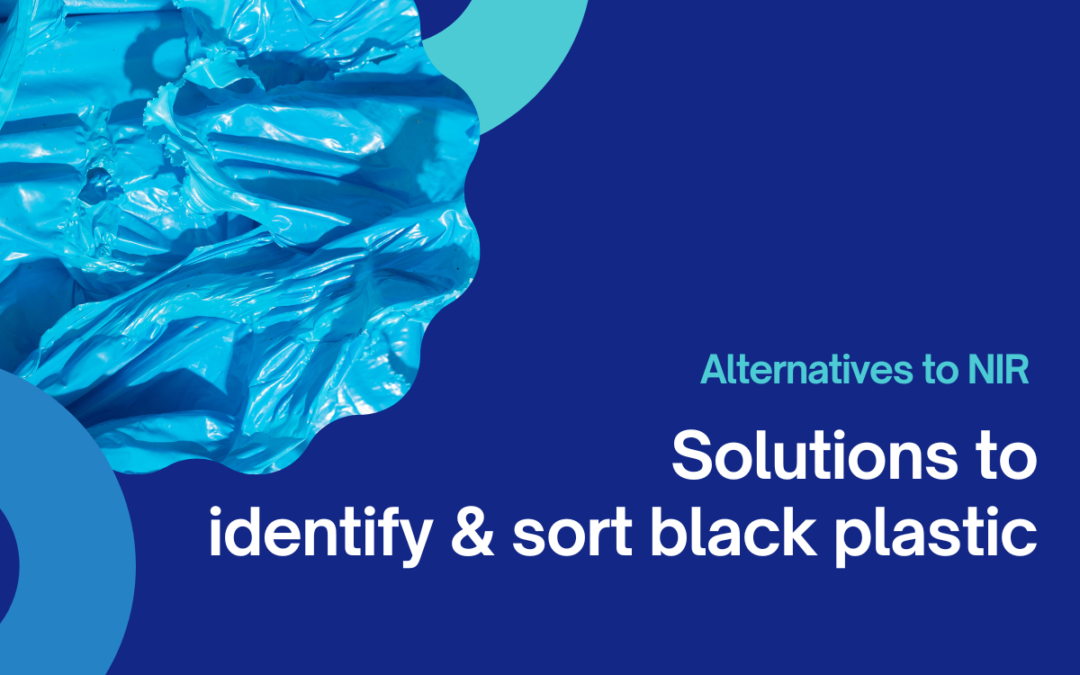NIR is a widely used technology in recycling for the identification of plastics. As it cannot detect black plastic, this article shows various devices that can identify black plastic.
NIR (near infrared spectroscopy – NIRS) is a widely used technology in plastics recycling for identification as it is fast, easy to use, non-destructive and therefore well established. We offer solutions based on NIR, from the portable, easy-to-use trinamiX plastic scanner, to our own solution, Solid Scanner, which works like a NIR minilab and offers the possibility of creating customised databases, to very fast HSI camera systems, suitable for in-line and real-time process control. What they all have in common is that NIR cannot detect carbon black coloured plastics. Unfortunately, black plastic is everywhere, but it is difficult to identify and therefore difficult to sort and recycle. As a result, plastics containing carbon black are often thermally recycled, which should be avoided.
Therefore, this article presents some alternative technologies that can detect and sort carbon black plastics, each with its own characteristics.
Why is black plastic so difficult to sort?
NIR is used as a sorting technique in virtually all large sorting plants. The technique is fast, simple and reliable. But because of the way it works physically, NIR cannot detect carbon black. Carbon black absorbs the entire NIR signal. As a result, Carbon black coloured plastics, i.e. black plastics, sometimes even (dark) grey plastics, cannot be detected and distinguished with the help of NIR.
Why is carbon black still used for colouring?
Carbon black is still a cheap and reliably available colourant, in other cases carbon black is the only way to achieve the desired mechanical properties. Even if a solution is found today to replace carbon black, there will still be carbon black on the market (e.g. many black components in the automotive industry) that will still be recycled years from now. Black plastics are and will remain a pressing issue.
Innovative Solutions for Identifying Black Plastic
This article presents technical solutions based on the following working principles:
- FTIR spectroscopy
- MIR spectroscopy
- Electrostatic charging
- Laser spectroscopy
- VIS object detection
Overview of properties of alternative technologies in direct comparison to NIR
FTIR
- Can measure black plastics and many other materials and directly quantify composition
- Also portable, significantly larger than portable NIR instruments
- More expensive to purchase
- Measurement time approx. 20-30 seconds
- Only spot measurements possible
- Technology mainly used in laboratory instruments
MIR
- Can detect black plastics
- Illumination in the MIR range requires significant power, so additional fire protection is required
- No portable units available
- Expensive to purchase
- Can also measure two-dimensional surfaces
Electrostatic charge
- Simple, mechanically robust technology
- Designed to separate binary mixtures
- High production output possible
- No portable units available
Laser spectroscopy
- Comparatively the most expensive technology
- No portable units available
- High production volumes possible
VIS object detection
- Lower hardware costs compared to other technologies due to VIS sensor technology
- Only recognises material for which it is trained
- Requires regular updating of AI-driven database
3 (more or less) portable solutions to identify black plastic
FTIR: Agilent 4300 Handheld & Agilent Cary 630 desktop system
The measurement time typically takes between a few seconds to several minutes. Sample preparation depends on the type of sample and the measurement method. Solid samples can be measured either as pellets or thin layers that can transmit IR light. To work with an FTIR instrument, one also needs some expert knowledge about the basics of infrared spectroscopy, how the interferometer and detector work, how to choose the appropriate measurement method and sample preparation, and how to interpret the IR spectra.
The Agilent 4300 Handheld FTIR spectrometer incorporates ease of use, ruggedness, and flexibility in one system. Weighing only ~2 kg, it is ideal for mobile nondestructive testing in field and nonlaboratory environments. It can analyze various samples with no adjustments needed. It’s used for analyzing polymers, coatings, composites, bulk material, cleaning verification, and even artifacts and artwork.
The Agilent Cary 630 FTIR Spectrometer is a desktop system, weighing ~ 4 kg.
Sliding spark spectroscopy: mIRoSpark
Sliding spark spectroscopy is a technique that uses high-voltage sparks to vaporize and ionize a small amount of the plastic surface, and then analyzes the emitted radiation to identify the different atoms present in the material. Some of the main advantages of this method are:
- It can detect additives like flame retardants and heavy metals that are not visible by near infrared spectroscopy.
- It can identify plastics of any color, size and structure, including black plastics, films, foils, granules, solid, foamed, carpets and textiles.
- It is fast, portable and easy to use, with a measurement time of one second and a simple pistol-like device that can be pressed on the sample.
Some of the main disadvantages of this method are:
- It requires contact between the measuring head and the sample surface, which may damage or contaminate the sample.
- It needs sample preparation to remove dust, dirt or paint from the sample surface
- It may not be able to distinguish between similar polymer types that have the same atomic composition but different molecular structures.
Sliding spark spectroscopy can also be used for analyzing metals, alloys, ceramics, and other inorganic materials.
The mIRoSpark device identifies plastics in various materials including household waste, electronic waste, carpets, and textiles. It weighs 14 kg and has a non-destructive mIRo-part for measurements. It can also identify black plastics with its SSS2-part. Measurement time is less than 1 second, and it can measure foils and granules. The device can also detect significant halogenated flame retardants and heavy metal additives.
4 industrial (inline) Solutions to identify carbon black
MIR: Steinert UniSort black
MIR spectroscopy is a technique that uses mid-infrared radiation to analyze the molecular structure and composition of plastics. Some of the main advantages of MIR spectroscopy are:
The plastic analysis method is fast, accurate, and non-destructive. It is capable of identifying various types of plastics, including additives, fillers, and contaminants that may impact the plastic’s properties and performance. Additionally, it can provide quantitative data on component concentration and distribution within the plastic sample.
Some of the main disadvantages of MIR spectroscopy are:
To perform this task, costly and advanced equipment and software are necessary, along with skilled operators and analysts. Additionally, it may have difficulty differentiating between certain plastics with comparable infrared spectra, such as PET and PBT.
The Steinert UniSort Black sorting unit sorts different materials, even black ones, effectively reducing sorting residues and increasing plastic extraction It utilizes NIR and MIR HSI camera technology to accurately identify all materials. Its classification system is designed to detect even dark or black objects that traditional NIR sorters may overlook, ensuring dependable recognition.
Electrostatic plastic sorting: Hamos EKS
Electrostatic plastic sorting is a process that exploits the effect that different plastics can be charged positively or negatively in different ways. The charged plastics are then separated by an electric field. This process has some advantages and disadvantages.
Advantages:
- It can also separate black plastics that are not visible to optical sorting equipment.
- It can achieve high purities of the individual plastic fractions.
- It can separate different plastics that do not differ in density or shape.
Disadvantages:
- It can only separate certain plastics that differ in their electrical conductivity.
- It cannot handle heavily soiled, painted or wet plastics.
The Hamos EKS Electrostatic Separators can separate mixed plastics. This achieves a purified plastics-fraction using a dry process at low processing costs. The systems can separate material mixtures of various plastics efficiently, regardless of their color, even black plastics. The polymer mixtures for separation need to be dry and dust-free with a particle size from 2 to 10 mm.
Laser spectroscopy: UniSensor Powersort 200
Sorting machines using laser spectroscopy in plastic recycling are devices that can identify and separate different types of plastics based on their optical properties. They use laser beams to measure the spectrum of light reflected or transmitted by the plastic flakes or pellets, and compare it with a database of known spectra for different polymers. This way, they can sort plastics by type (such as PET, HDPE, uPVC), color, or quality.
Some advantages of sorting machines using laser spectroscopy in plastic recycling are:
- They can detect and remove contaminants such as metals, rubber, or other foreign materials that may affect the quality of the recycled plastic.
- They can sort plastics that are difficult to distinguish by conventional methods, such as dark or black plastics, or same-in-color polymers (such as PVC, PP, and PE).
Some disadvantages of sorting machines using laser spectroscopy in plastic recycling are:
- They may require high initial investment and maintenance costs, as they involve complex and sophisticated technology.
- They may not be able to sort plastics that have similar spectra, such as some bioplastics or blends.
- They may generate waste or emissions from the laser process, such as heat, dust, or ozone.
The UniSensor Powersort 200 can sort up to 3 tons per hour based on density. It generates and evaluates up to 1 million spectra per second using a powerful signal processor and high-resolution optics. It can even sort particles as small as 2 square millimeter.
VIS object recognition: AMP Robotics & Max-AI
VIS object recognition requires the use of artificial intelligence (AI) and robotic systems to sort and recycle plastic waste. The technology uses computer vision and deep learning to identify different types of plastic based on their shape, colour, texture and label. Each system is only able to recognise plastics that have been previously trained. The cost of the VIS sensor and light source is much lower than the hardware cost of other sensor technologies. This solution is best suited for large plastic parts, i.e. the solution can only be used before the packaging has been shredded.
AMP Robotic’s system consists of a vision system that analyses the material composition, colour, clarity, opacity and form factor of plastics, and a delta-style robot that picks and places the plastics into designated bins. Its object recognition database requires regular updating. The database currently includes water bottles, milk jugs, lids, tubs, cups, cartons, clamshells, coffee pods & thin films and materials such as PET, HDPE, LDPE, PP, PS.
Another manufacturer of this technology is Max-AI.
What developments are there in sensor technology that can detect black plastics?
A few years ago, the Fraunhofer project BlackValue attracted a lot of attention. Its goal was to develop an automated solution for industrial use. The main focus was on terahertz sensor technology. However, there have been no industrially usable results so far.
A new project at SKZ is currently being planned and aims at a portable solution based on AI.
What alternative methods are there to detect black plastics?
Another possibility is the use of special markers or tracers that are added to the black plastics and glow or fluoresce under certain conditions. These can then be detected by optical sensors. Polysecure, for example, has developed technology that can invisibly mark and track materials and products. They have also developed Tracer-Based Sorting (TBS) technology that can efficiently and reliably sort many material and waste streams into any desired fraction. However, these markers need to be customised for each type of polymer and require close cooperation between manufacturers, recyclers and authorities.
There are also ideas to apply markers that indicate the type of plastic, for example barcodes or RFID tags. However, these markings must be standardised and readable and must not interfere with the recycling process.
Basically, there are also many ideas to replace carbon black or increase the NIR reflectivity with suitable additives and other colourants, such as colour pigments. We offer corresponding solutions to be able to check the NIR detectability of plastics already in the development phase.
For these reasons (lack of standardisation, disruption of the recycling process and costs), these solutions have not yet gained widespread acceptance.
Conclusion
Black plastics remain a major recycling challenge. NIR enables portable and easy-to-use devices. However, NIR-based devices cannot detect, not to mention sort, black plastics. Alternative technologies are available. However, technical solutions for black plastics based on technologies such as FTIR, MIR, visual sensing, laser spectroscopy or sliding spark spectroscopy are significantly more expensive to purchase, usually not portable, more complex to operate or can only separate 2 plastics per step. This article showed some commercially available technical solutions for the detection of black plastics and gave an insight into past and current research projects on this topic.
Identifying black plastics is a challenging but worthwhile endeavor for businesses looking to improve efficiency and sustainability. While the technical issues, cost implications, and difficulty of changing habits are all obstacles to be aware of, they can be surmounted with the right approach. By taking into account all of these factors, businesses can successfully identify black plastics and reap the rewards that come along with it.
About us – Solid Scanner
Let’s take responsibility and recycle more plastics – ask us for suitable solutions. Our portfolio includes solutions ranging from small, portable solutions to individual solutions based on hyperspectral camera systems for simple, automated identification of plastic materials in the sorting process and inline process control, e.g. for homogeneity.
About trinamiX – the sensor company
trinamiX GmbH, based in Ludwigshafen, Germany, was founded in 2015 as a wholly owned subsidiary of BASF SE. As a startup within the company, it is not only operationally independent, but also has unique access to the expertise and experience of the entire BASF Group.
Its patent-pending technologies enable people and machines to grasp the hidden and invisible worlds around them to make better decisions and increase safety.
Contact us
Please contact us for further information, a concrete offer and questions about availability and delivery times of our products, e.g. the NIR solution from trinamiX.
Related information
Portable plastic identification solution from trinamiX (product information)
Minilab Solid Scanner (product information)
Why NIR is used in Plastics Recycling?
Links
Products
Agilent Cary 630 FTIR Spectrometer
R&D projects
SKZ – Süddeutsches Kunststoffzentrum
Tracker


